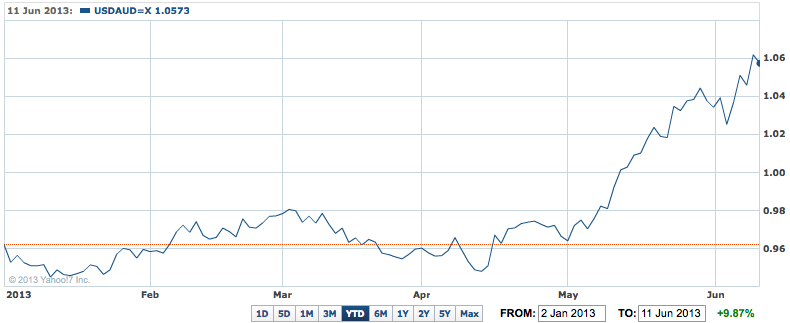Another rough day for the Australian dollar with new 32 month lows set in Asian trading yesterday and in European and US trading overnight.
Fears about China and plans by the Japanese government to slash taxes to try and boost business investment were said to be behind the fall – which at one stage saw the current dip to a 32 month low of 93.26 USc, before it recovered back over 94 US cents, to trade at 94.50 this morning.
The currency’s fall has gotten the experts all gloomy about the currency. Goldman Sachs has cut its forecasts for the dollar to 85 USc to be reached within a year – previously it had been predicting the dollar to be US90¢.
The National Australia Bank revised its Australian dollar forecasts to 93c by the end of this year and 87¢ by late next year.
But the Commonwealth Bank reckons the dollar will recover ground over the remainder of this year and move to US96¢ and then dip lower.
USDAUD YTD – Greenback’s Strength Continues To Clip The Aussie

The news didn’t hit confidence on the stock market as it seemed to do on a couple of days last week when the currency dipped sharply.
The ASX 200 and the All Ords ended with gains of 19 points or around 0.4% on the day.
But that will reverse today after another night of volatile trading offshore with Wall Street, gold and oil all taking a hit.
The dollar is now down nearly 10% from its high of $US1.0498 earlier this year and 8% since the Reserve Bank’s rate cut on May 7.
That though hasn’t been the major influence, nor has the easing in China’s economy or the flow of weak data here.
It’s been the steady strengthening in the value of the US dollar as more and more pundits reckon the Fed will start easing its spending spree sooner than later.
Not helping sentiment about the Aussie dollar was the move by Standard & Poor’s to take the US credit rating off its AA plus negative and boost it to a stable outlook.
With the US deficit falling and the amount of debt being issued reducing, it means there is little chance of another downgrade in the rating – unless politicians in Washington manage to repeat their August 2011 snafu on raising the debt ceiling and forcing US to the brink of default on its debts.
There is a repeat of that debacle slowly building in Washington right now, along with the impact of the spending cuts from the automatic sequestration which started a couple of months ago. S&P’s upgrade means it expects the present problems with the debt ceiling will be resolved.
Much to the surprise of the market, yesterday’s data flow showed home loan approvals rise by a seasonally adjusted 0.8%.
Economists expected a rise of 2%, after the biggest jump in home loans for four years in March. But some economists had been looking for a fall of 1%.
And the NAB’s monthly business survey showed a small improvement in business conditions, while confidence was unchanged at weak levels, but ‘‘mediocre’’.













